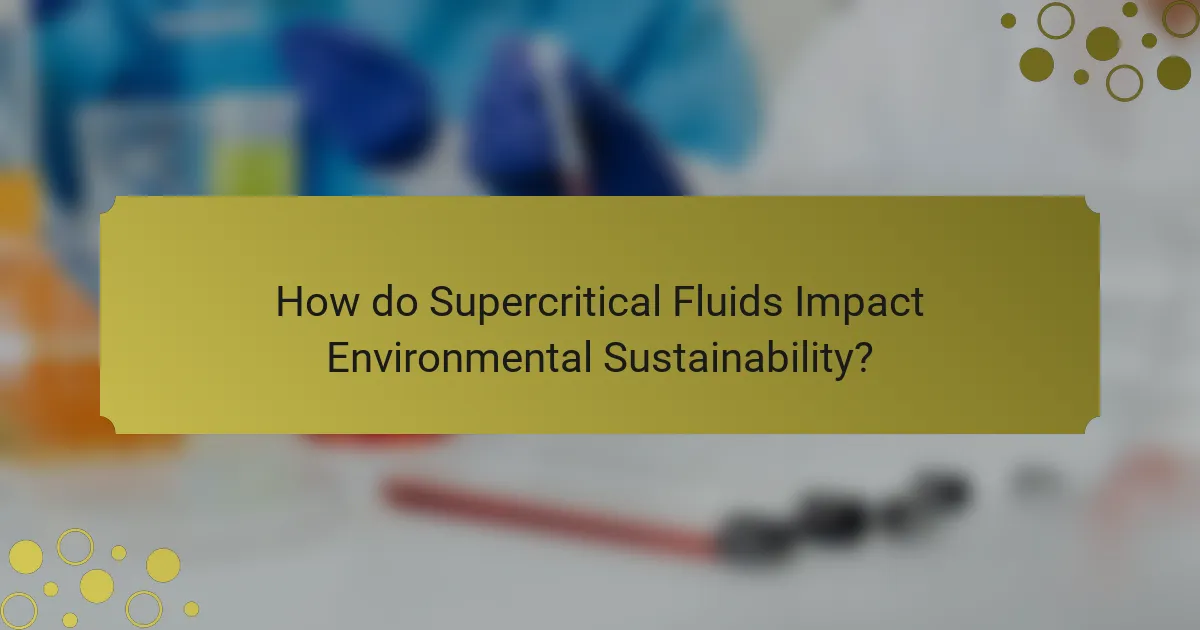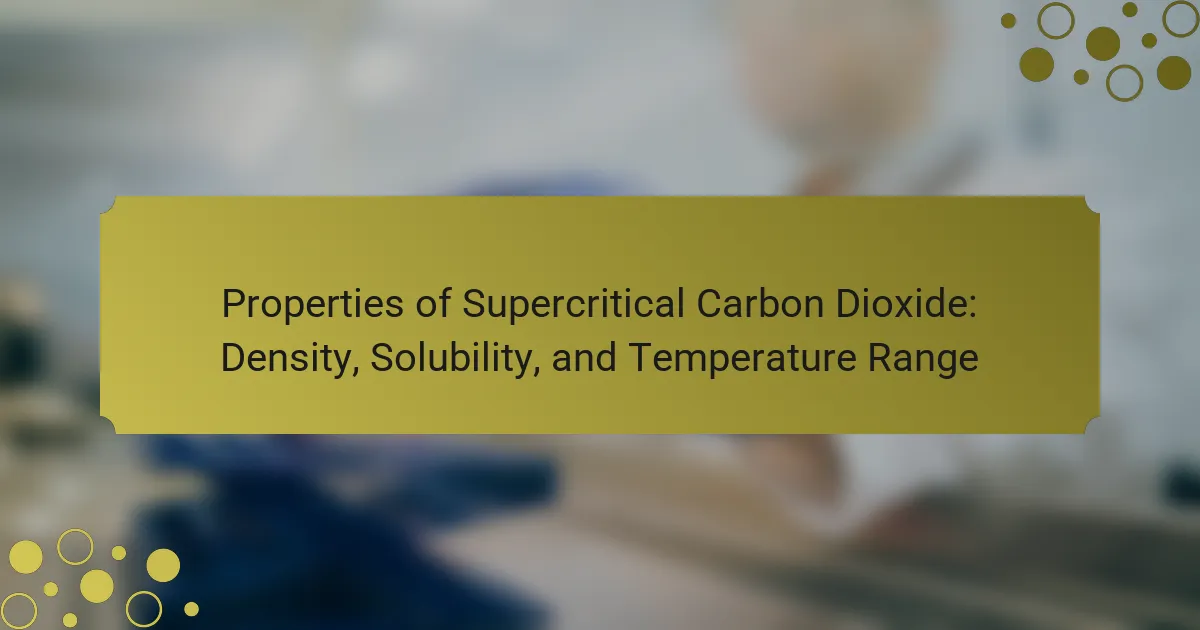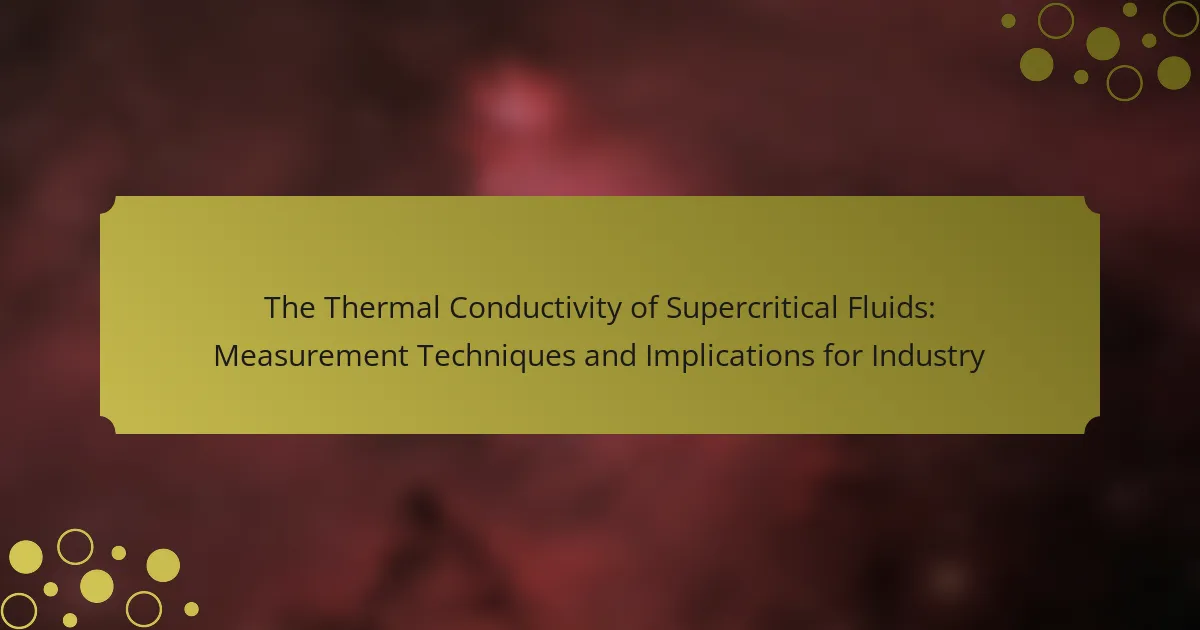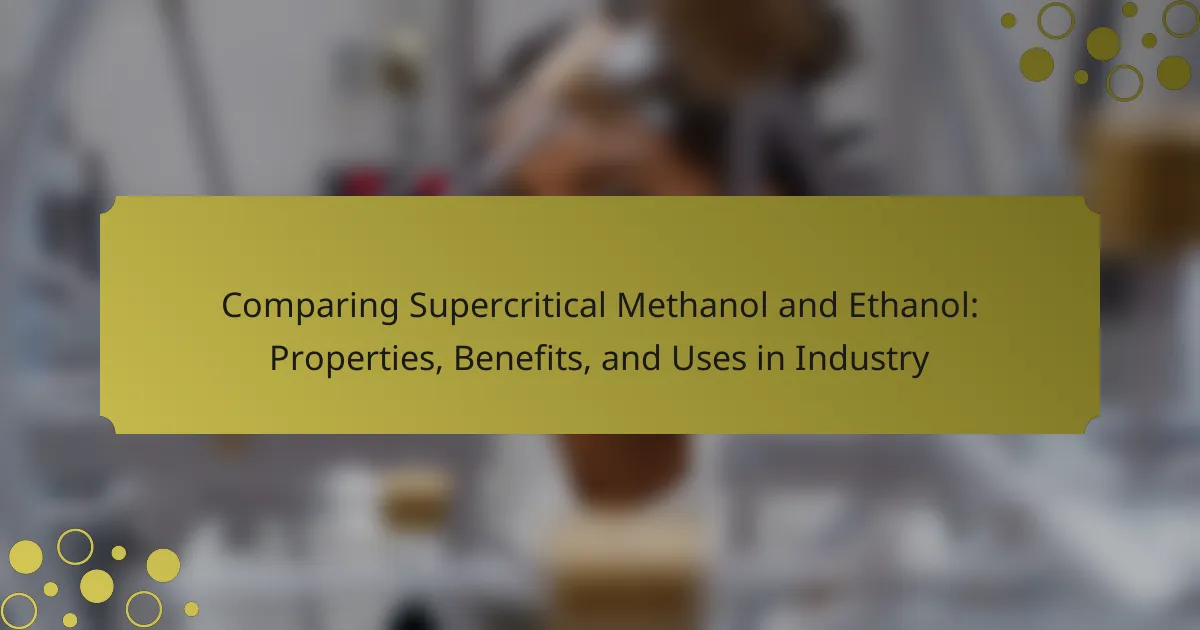Supercritical fluids are substances that exist above their critical temperature and pressure, where they exhibit unique solvent properties. This article explores the role of supercritical fluids, particularly supercritical carbon dioxide, in extraction processes across various industries, including food, pharmaceuticals, cosmetics, and environmental remediation. Supercritical fluid extraction (SFE) offers advantages such as higher efficiency, reduced use of harmful solvents, and enhanced environmental sustainability. The article discusses how SFE minimizes chemical waste, lowers energy consumption, and provides a cleaner alternative for extracting valuable compounds while ensuring the quality and integrity of the products.

What are Supercritical Fluids and Their Role in Extraction?
Supercritical fluids are substances at a temperature and pressure above their critical point, where distinct liquid and gas phases do not exist. In this state, they possess unique properties that allow them to act as effective solvents. This makes them particularly useful in extraction processes.
Supercritical carbon dioxide is the most commonly used supercritical fluid in extraction. It can dissolve a wide range of compounds, making it ideal for extracting essential oils, flavors, and pharmaceuticals. The efficiency of supercritical fluid extraction (SFE) is higher compared to traditional methods.
SFE minimizes the use of hazardous organic solvents, thus reducing environmental impact. The process is tunable by adjusting temperature and pressure, allowing for selective extraction of desired compounds. This versatility enhances the overall effectiveness of extraction operations.
How do supercritical fluids differ from traditional solvents?
Supercritical fluids differ from traditional solvents primarily in their unique state of matter. Supercritical fluids exist at conditions above their critical temperature and pressure, combining properties of both gases and liquids. This allows them to diffuse through solids like a gas while dissolving materials like a liquid. Traditional solvents, in contrast, remain in either a liquid or gas state and lack this dual capability.
The solvent power of supercritical fluids can be adjusted by changing temperature and pressure, enabling selective extraction of compounds. Traditional solvents have fixed solvent properties that do not offer such versatility. Additionally, supercritical fluids often have lower toxicity and environmental impact compared to many traditional solvents, which can be harmful or volatile.
Research indicates that supercritical carbon dioxide, for example, is a popular choice for extraction due to its non-toxic nature and effectiveness. This combination of properties makes supercritical fluids advantageous in various applications, including food and pharmaceutical industries.
What are the key properties of supercritical fluids that make them effective for extraction?
Supercritical fluids possess unique properties that enhance their effectiveness for extraction. They exhibit low viscosity, allowing for better [censured] into materials. Their high diffusivity enables rapid extraction processes. Supercritical fluids can dissolve a wide range of compounds, increasing solvent power. They also have tunable densities, which can be adjusted by changing temperature and pressure. This adjustability allows for selective extraction of specific compounds. Additionally, supercritical fluids are environmentally friendly, often being non-toxic and biodegradable. These properties collectively make them superior solvents in extraction applications.
How does temperature and pressure influence the behavior of supercritical fluids?
Temperature and pressure significantly influence the behavior of supercritical fluids. Supercritical fluids exist at temperatures and pressures above their critical points. At these conditions, they exhibit unique properties that differ from gases and liquids. Increasing temperature typically enhances the solvent power of supercritical fluids. This is due to increased kinetic energy, which allows for better solute interaction. Conversely, increasing pressure can lead to higher density in supercritical fluids. Higher density enhances the solvation ability of the fluid. Research shows that optimal temperature and pressure conditions can maximize extraction efficiency. For example, carbon dioxide as a supercritical fluid has a critical temperature of 31.1°C and a critical pressure of 73.8 bar. Adjusting these parameters allows for targeted extraction of various compounds.
What advantages do supercritical fluids offer in extraction processes?
Supercritical fluids offer several advantages in extraction processes. They provide high solvent power, allowing for the extraction of a wide range of compounds. Supercritical fluids can easily penetrate solid matrices, enhancing extraction efficiency. Their tunable properties enable selective extraction by adjusting temperature and pressure. This selectivity minimizes the co-extraction of unwanted substances. Supercritical fluids are often non-toxic and environmentally friendly, reducing hazardous waste. Additionally, they can be recycled within the process, lowering operational costs. Overall, these characteristics make supercritical fluids a superior choice for efficient and sustainable extraction.
How do supercritical fluids enhance extraction efficiency compared to conventional methods?
Supercritical fluids enhance extraction efficiency by providing superior solvent properties compared to conventional methods. They can penetrate solid matrices more effectively due to their low viscosity. This results in a higher mass transfer rate during extraction. Supercritical fluids also have tunable density, allowing for optimized solubility of target compounds. This adaptability leads to selective extraction of desired substances while minimizing impurities. Studies show that supercritical carbon dioxide can extract essential oils more efficiently than organic solvents. Additionally, the extraction process often occurs at lower temperatures, preserving thermally sensitive compounds. Overall, these factors contribute to higher yields and better quality extracts.
What are the specific benefits of using supercritical carbon dioxide as a solvent?
Supercritical carbon dioxide (CO2) offers several specific benefits as a solvent. It has a tunable solvent power, which allows for selective extraction of compounds. Supercritical CO2 can dissolve non-polar and slightly polar substances effectively. It operates at low temperatures, preserving heat-sensitive compounds during extraction. Additionally, supercritical CO2 is non-toxic and environmentally friendly, reducing hazardous waste. Its ability to be recycled makes it cost-effective in the long run. Studies show that supercritical CO2 extraction can yield higher quality products compared to traditional solvents. The efficiency of extraction processes using supercritical CO2 is often significantly improved, leading to shorter processing times.

How do Supercritical Fluids Impact Environmental Sustainability?
Supercritical fluids positively impact environmental sustainability by reducing the use of harmful solvents. They offer a cleaner alternative for extraction processes. This reduces chemical waste and pollution. Supercritical CO2, for example, is non-toxic and recyclable. Its use minimizes the carbon footprint of extraction methods. Studies show that supercritical fluid extraction can achieve high efficiencies with lower energy consumption. This contributes to sustainable practices in various industries, including food and pharmaceuticals. Overall, the adoption of supercritical fluids promotes environmentally friendly extraction techniques.
What are the environmental benefits of using supercritical fluids in extraction?
Supercritical fluids in extraction provide significant environmental benefits. They reduce the use of harmful organic solvents. This minimizes toxic waste generation. Supercritical fluids are often derived from renewable resources. Their use leads to lower energy consumption compared to traditional methods. They also enable selective extraction, reducing the need for multiple processes. Studies show that supercritical CO2 extraction can yield high purity products. This process is more environmentally friendly due to its lower carbon footprint.
How do supercritical fluids reduce the use of harmful solvents?
Supercritical fluids reduce the use of harmful solvents by providing an alternative extraction medium. They possess unique properties that allow them to dissolve a wide range of compounds effectively. Supercritical carbon dioxide is commonly used due to its low toxicity and non-flammability. This fluid can extract compounds at lower temperatures, minimizing thermal degradation. Additionally, supercritical fluids can be easily removed from the final product, leaving no harmful residues. Research shows that using supercritical fluids can significantly decrease the reliance on organic solvents, which are often hazardous. In many applications, this method has demonstrated a reduction in environmental impact compared to traditional solvent-based processes.
What is the impact of supercritical fluid extraction on waste generation?
Supercritical fluid extraction (SFE) significantly reduces waste generation compared to traditional extraction methods. SFE utilizes supercritical fluids, often carbon dioxide, which are more efficient in extracting desired compounds. This process minimizes the use of organic solvents, which are typically associated with hazardous waste. Studies show that SFE can lead to a reduction in waste by up to 90% when compared to conventional extraction methods. The efficiency of SFE also means that less raw material is needed to achieve the same yield, further decreasing waste. Additionally, the waste produced is often less toxic and easier to manage. Overall, SFE presents a more sustainable approach to extraction, aligning with environmental goals.
What challenges are associated with the use of supercritical fluids in extraction?
The challenges associated with the use of supercritical fluids in extraction include high operational costs and technical complexity. The equipment required for supercritical fluid extraction is expensive. Additionally, maintaining the necessary pressure and temperature conditions can be technically demanding. There is also a need for specialized training to operate this equipment effectively. The solubility of compounds can vary significantly, making method development challenging. Furthermore, some materials may require extensive optimization to achieve desired extraction efficiencies. These factors can limit the widespread adoption of supercritical fluid extraction in certain industries.
What are the economic considerations of implementing supercritical fluid extraction systems?
The economic considerations of implementing supercritical fluid extraction systems include initial investment, operational costs, and potential return on investment. Initial investment costs can be high due to the need for specialized equipment and technology. For instance, supercritical fluid extraction systems often require high-pressure vessels and advanced pumping systems. Operational costs involve energy consumption, maintenance, and labor. Energy costs can vary based on the scale of operation and the type of supercritical fluid used.
Additionally, the efficiency of extraction can lead to higher yields, which may offset some operational costs. Studies indicate that supercritical fluid extraction can produce higher quality extracts compared to traditional methods, potentially leading to increased market value. The return on investment can be favorable, particularly in industries like pharmaceuticals and food processing, where high-quality extracts are in demand.
Overall, while the upfront costs can be significant, the long-term economic benefits can justify the investment in supercritical fluid extraction systems.
How can the scalability of supercritical fluid extraction be improved?
Increasing the scalability of supercritical fluid extraction (SFE) can be achieved through several strategies. Optimizing process parameters such as temperature and pressure enhances extraction efficiency. Utilizing advanced equipment designs, like continuous flow systems, allows for larger batch processing. Implementing automation can also streamline operations and reduce labor costs. Additionally, selecting appropriate solvents improves solute recovery rates. Research indicates that scaling up from laboratory to industrial settings requires careful consideration of equipment size and material compatibility. These adjustments can lead to improved extraction yields and reduced operational costs.

What are the Applications of Supercritical Fluids in Various Industries?
Supercritical fluids have diverse applications across various industries. In the food industry, supercritical CO2 is used for extracting flavors and essential oils. This method preserves the quality and integrity of the compounds. In pharmaceuticals, supercritical fluids aid in drug formulation and delivery. They enhance solubility and bioavailability of active ingredients. The cosmetics industry utilizes supercritical fluids for producing natural extracts and formulations. This process ensures purity and effectiveness of cosmetic products. In the environmental sector, supercritical fluids are employed for waste treatment and remediation. They facilitate the breakdown of hazardous materials. Supercritical fluids also play a role in the production of advanced materials. They assist in the synthesis of nanoparticles and polymers. Overall, supercritical fluids offer efficient and environmentally friendly solutions across multiple sectors.
In which industries is supercritical fluid extraction most commonly utilized?
Supercritical fluid extraction is most commonly utilized in the food, pharmaceutical, and cosmetic industries. In the food industry, it extracts flavors, essential oils, and caffeine from coffee. The pharmaceutical industry uses it to isolate active compounds and purify drugs. In cosmetics, it extracts natural ingredients for skincare products. These industries benefit from the efficiency and selectivity of supercritical fluid extraction. Studies show that it can enhance yield and quality while reducing solvent residues.
How is supercritical fluid extraction applied in the food and beverage industry?
Supercritical fluid extraction (SFE) is used in the food and beverage industry to efficiently extract flavors, aromas, and bioactive compounds. It utilizes supercritical carbon dioxide as a solvent, which is non-toxic and environmentally friendly. SFE allows for the extraction of essential oils from herbs and spices without altering their chemical structure. This method preserves the quality and integrity of sensitive compounds. It also reduces the need for harmful organic solvents, making it safer for consumers. Research shows that SFE can extract higher yields compared to traditional methods. Studies indicate that SFE can enhance the extraction of antioxidants from plant materials. The food and beverage industry increasingly adopts SFE for its efficiency and sustainability benefits.
What role do supercritical fluids play in the pharmaceutical industry?
Supercritical fluids are utilized in the pharmaceutical industry primarily for extraction and purification processes. They offer high solubility for a wide range of compounds. This property enhances the efficiency of extracting active pharmaceutical ingredients. For instance, supercritical carbon dioxide is commonly used due to its favorable characteristics. It is non-toxic and environmentally friendly. Additionally, supercritical fluids can be tuned to selectively dissolve specific compounds. This selectivity helps in isolating desired substances with minimal impurities. Research indicates that supercritical fluid extraction can yield higher purity levels compared to traditional methods. The application of supercritical fluids also reduces the need for organic solvents, aligning with green chemistry principles.
What innovations are shaping the future of supercritical fluid extraction?
Innovations shaping the future of supercritical fluid extraction (SFE) include advancements in technology and methodology. Enhanced equipment designs improve efficiency and reduce energy consumption. Integration of artificial intelligence optimizes extraction processes by analyzing parameters in real time. Development of new solvents expands the range of extractable compounds. Miniaturization of extraction systems allows for on-site applications and reduces waste. Research into tunable supercritical fluids enables precise control over extraction conditions. These innovations collectively enhance the effectiveness and sustainability of SFE in various industries.
How are advancements in technology enhancing the efficiency of supercritical fluid extraction?
Advancements in technology are enhancing the efficiency of supercritical fluid extraction (SFE) by optimizing process parameters and improving equipment design. Enhanced sensors and automation systems allow for precise control of temperature and pressure. This leads to better extraction yields and reduced processing times. New materials for extraction vessels offer higher resistance to temperature and pressure, increasing operational safety. Improved algorithms for data analysis enable real-time monitoring and adjustments during extraction. Research shows that these advancements can increase extraction efficiency by up to 30%. Additionally, innovations in CO2 recycling reduce operational costs and environmental impact. Overall, technological advancements significantly boost the effectiveness and sustainability of SFE processes.
What are the emerging trends in the use of supercritical fluids for sustainable extraction?
Emerging trends in the use of supercritical fluids for sustainable extraction include increased application in food and pharmaceutical industries. These fluids are gaining popularity due to their ability to extract compounds without harmful solvents. Innovations in equipment design are enhancing extraction efficiency and reducing energy consumption. There is a shift towards using carbon dioxide as a primary solvent, which is non-toxic and environmentally friendly. Research indicates that supercritical fluid extraction can yield higher purity products. Additionally, advancements in process optimization are improving scalability for industrial applications. The trend towards green chemistry is driving further exploration of supercritical fluids in various extraction processes.
What best practices should be followed when using supercritical fluids in extraction?
Best practices for using supercritical fluids in extraction include optimizing temperature and pressure conditions. These parameters significantly affect solubility and extraction efficiency. It is essential to select the right supercritical fluid, often carbon dioxide, for specific target compounds. Maintaining a consistent flow rate enhances extraction reproducibility. Regularly monitoring the extraction process helps identify any deviations in performance. Properly purging the system after extraction prevents contamination. Using appropriate materials that withstand high pressures and temperatures ensures safety and equipment longevity. Following these practices improves overall extraction efficiency and product quality.
Supercritical fluids, particularly supercritical carbon dioxide, serve as effective solvents in extraction processes due to their unique properties that combine characteristics of both gases and liquids. This article explores the role of supercritical fluids in enhancing extraction efficiency, reducing environmental impact, and minimizing the use of hazardous solvents. Key advantages include tunable solvent power, lower toxicity, and improved yields compared to traditional methods. Additionally, the article addresses the applications of supercritical fluids across various industries, the challenges associated with their use, and emerging trends that promote sustainable extraction practices.



